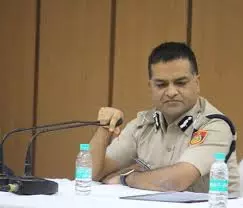Dilip Cherian | Chief secy, ADGP for Chandigarh a ‘punishment’ for Punjab govt?

Chandigarh, the city that wears two hats as the shared capital of Punjab and Haryana, is back in the spotlight — but not for its architectural charm or serene lake. Two recent decisions by the Centre have stirred a cocktail of political uproar and administrative change, leaving Punjab fuming and bureaucratic systems reshuffled.
First, the ministry of personnel dropped a bombshell by abolishing the post of adviser to the Chandigarh administrator, replacing it with the post of chief secretary of the Union Territory. While the notification might seem like routine tinkering, its political implications hit like a thunderclap. The Aam Aadmi Party (AAP), Congress, and Shiromani Akali Dal (SAD) — otherwise rivals — found common ground in slamming the BJP-led Centre. The ruling sentiment? This isn’t just about a title swap; it’s a perceived blow to Punjab’s dignity and rights over the UT.
Meanwhile, another Centre-driven decision shook the Chandigarh Police structure. The force now has sanctioned posts for an additional director general of police (ADGP) and deputy inspector general (DIG), replacing the earlier practice of IGP-led hierarchy. While this reordering won’t displace the current leadership — ADGP Surender Singh Yadav already heads the police — it signals a formal shift towards aligning Chandigarh’s policing framework with other Union Territories.
The timing of these announcements is striking. For Punjab which has long viewed Chandigarh as its rightful territory, these moves feel like a strategic snub. For the Centre, it’s perhaps an attempt to streamline administration. Either way, this twin development underscores the need for a broader conversation on Chandigarh’s governance. The city deserves better than being in a perennial tug-of-war.
Decoding the Centre’s surprising mid-Budget shuffle
True to its reputation for springing surprises, the Centre has reshuffled key administrative positions, swapping revenue secretary Arunish Chawla (IAS: 1992: BH) with department of investment and public asset management (Dipam) secretary Tuhin Kanta Pandey (IAS: 1987: OD). Mr Pandey, now revenue secretary, steps into this crucial role while Mr Chawla takes over as the secretary of Dipam. The move, coming right in the middle of the Union Budget season, has certainly raised eyebrows.
The reshuffle relieves Mr Pandey of his additional responsibilities with the department of public enterprises (DPE), allowing him to focus exclusively on his ministry of finance role just months before his retirement on July 31. Meanwhile, Mr Chawla inherits the dual burdens of the culture ministry and DPE, on top of his new role in Dipam. With service tenure until 2028, Mr Chawla seems to have a longer runway to navigate these responsibilities.
Both Mr Pandey and Mr Chawla are trusted hands within the corridors of power in New Delhi. However, the timing and nature of this reshuffle have fuelled speculation. The revenue department, especially ahead of the Union Budget, is an intense portfolio requiring constant attention. While some argue that Mr Chawla’s additional workload — especially with major events like Republic Day and Maha Kumbh — might have influenced the decision, others point out that such factors were likely considered when he was appointed revenue secretary just weeks ago.
Sceptics view the reshuffle as a reflection of the government’s preference for experience, with Mr Pandey’s familiarity with budgetary matters giving him an edge. Even so, the abruptness of the move has left many officials puzzled, though the government’s prerogative in such matters leaves little room for debate.
Empowering citizens or policing narratives?
The Uttar Pradesh police’s initiative to enlist social media influencers and students as “digital warriors” has sparked interest and debate. The plan is ambitious: Counter fake news, spread cybercrime awareness and highlight police achievements. While this effort builds on an earlier “digital volunteers” programme, its expanded scope raises questions about its real intent.
Previously, the police relied on volunteers like teachers, lawyers, and retired soldiers, connected via WhatsApp, to report crimes and debunk rumours. Now, with the Maha Kumbh Mela 2025 underway, they’re targeting tech-savvy students and influencers to operate across platforms like Instagram and X (formerly Twitter). The strategy includes workshops, cyber-awareness training, and creating cyber clubs in schools to foster critical thinking and digital literacy.
On the surface, this appears to be well-structured. It’s voluntary and aims to empower youth to tackle online misinformation. Influencers see it as a way to contribute positively to society. However, the campaign coincides with the government’s New Digital Media Policy, 2024, which incentivises influencers to promote state achievements with rewards of up to ₹8 lakh a month while threatening legal action against “objectionable” or “anti-national” content.
This overlap blurs the lines between combating fake news and controlling the narrative. While training students to analyze and verify information is commendable, the risk of turning digital warriors into unpaid propagandists is real. Programmes like this should prioritize public interest over public relations, ensuring they don’t become tools to stifle dissent or overly glorify the state.
Empowering citizens to fight misinformation is critical in today’s digital age. But the balance between fostering genuine engagement and serving political agendas is delicate. If the focus remains on public empowerment and transparency, “digital warriors” could be a transformative initiative. Otherwise, it risks being dismissed as yet another PR exercise.
